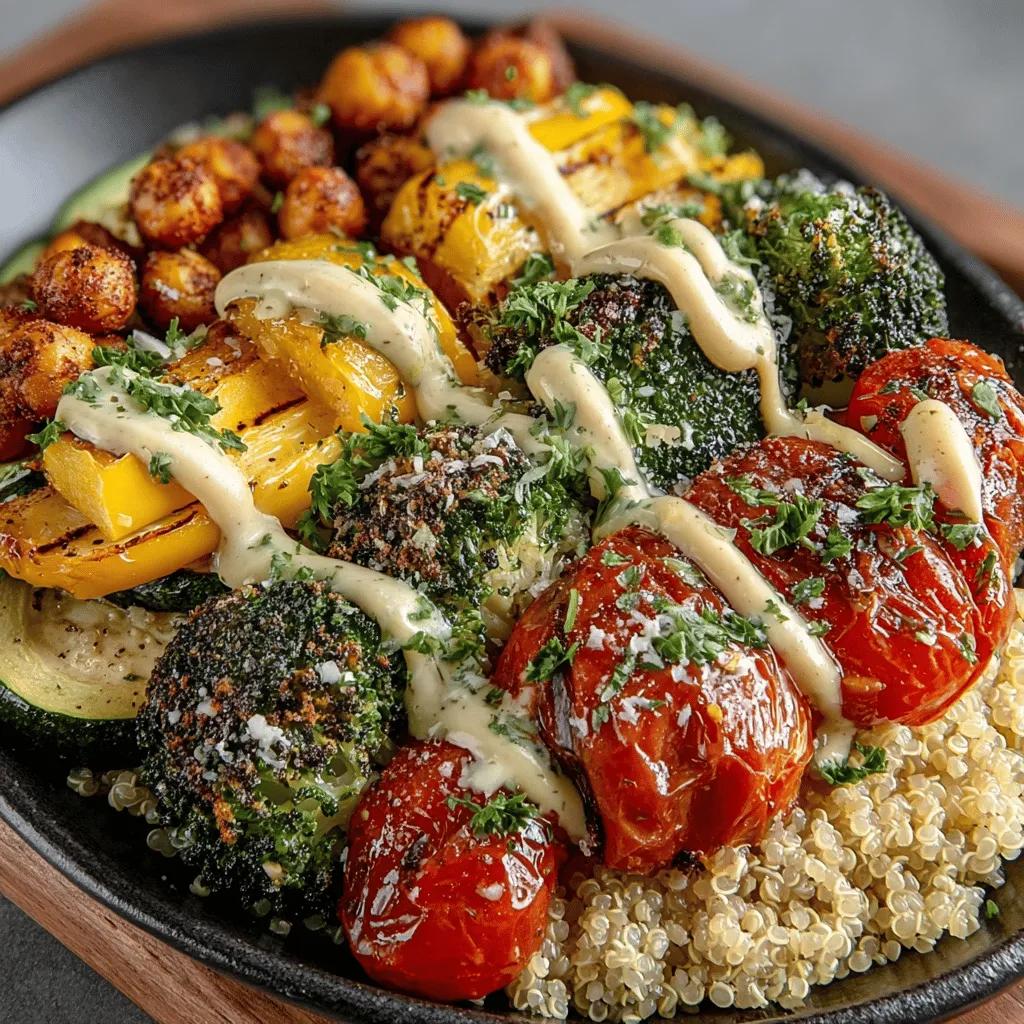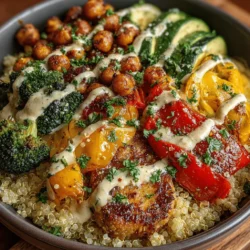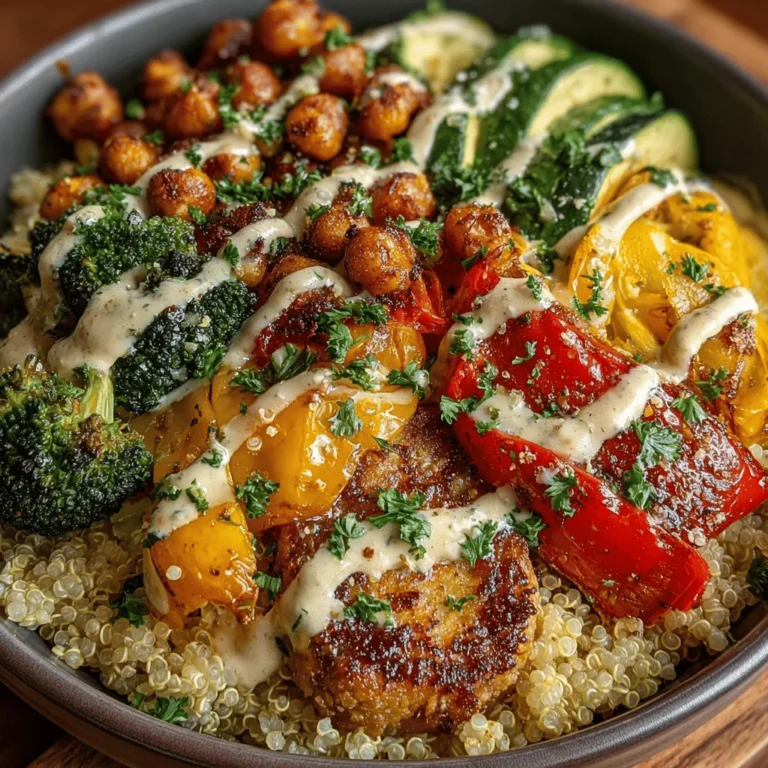Introduction
Power bowls have surged in popularity as a nutritious meal option that combines a variety of ingredients into one satisfying dish. These bowls are not only visually appealing but are also a fantastic way to incorporate a range of nutrients into your diet. At the heart of our recipe is quinoa, often hailed as a superfood due to its impressive nutritional profile. Packed with protein, fiber, and essential vitamins, quinoa serves as a perfect base for our colorful roasted vegetables. These veggies not only enhance the flavor of the dish but also contribute a wealth of nutrients, making this recipe suitable for various dietary preferences, including vegan and gluten-free diets. Ready to explore the wholesome goodness of Quinoa and Roasted Veggie Power Bowls? Let’s get started!
Ingredients
– 1 cup quinoa
– 2 cups water or vegetable broth
– 1 medium zucchini, diced
– 1 red bell pepper, chopped
– 1 cup cherry tomatoes, halved
– 1 cup broccoli florets
– 1 small red onion, sliced
– 1 can (15 oz) chickpeas, drained and rinsed
– 3 tablespoons olive oil
– 2 tablespoons tahini
– 1 teaspoon garlic powder
– Salt and pepper to taste
– Fresh parsley or cilantro for garnish (optional)
Instructions
1. Preheat your oven to 400°F (200°C).
2. Rinse the quinoa under cold water to remove bitterness. In a medium saucepan, combine quinoa and water (or vegetable broth) and bring to a boil. Reduce heat, cover, and simmer for 15 minutes or until the quinoa is fluffy and all liquid is absorbed. Set aside.
3. While the quinoa is cooking, prepare the vegetables. On a large baking sheet, combine zucchini, red bell pepper, cherry tomatoes, broccoli, and red onion. Drizzle with olive oil and sprinkle with garlic powder, salt, and pepper. Toss to coat evenly.
4. Roast the vegetables in the preheated oven for 20-25 minutes, or until they are tender and slightly caramelized, stirring halfway through the cooking time.
5. In a small bowl, mix tahini with a splash of water to create a smooth dressing. Adjust the consistency with more water if needed and season with salt.
6. Once the vegetables are done roasting, combine the cooked quinoa and roasted veggies in a large bowl. Add the chickpeas and drizzle with the tahini dressing. Toss gently to combine.
7. Serve warm, garnished with fresh parsley or cilantro if desired.
Understanding Quinoa: The Superfood
Quinoa, pronounced keen-wah, is a grain-like seed that hails from the Andean region of South America. It is often referred to as a pseudo-cereal due to its unique nutritional properties. Quinoa comes in several varieties, including white, red, and black, each offering a slightly different flavor and texture.
Nutritionally, quinoa stands out as a complete protein source, containing all nine essential amino acids, making it particularly valuable for vegetarians and vegans. Additionally, quinoa is rich in fiber, vitamins B and E, and minerals such as magnesium, iron, and zinc. Incorporating quinoa into your meals can help support digestive health, aid in weight management, and provide sustained energy throughout the day.
When selecting quinoa, look for seeds that are clean and free from debris. Store it in an airtight container in a cool, dry place, and it can last for several months.
The Power of Roasted Vegetables
Roasting vegetables is a simple yet effective cooking method that enhances the natural flavors and sweetness of the produce. When vegetables are exposed to high heat, their sugars caramelize, resulting in a delicious, rich taste that can elevate any dish.
In this power bowl, we feature a variety of vegetables, each offering unique nutritional benefits. Zucchini is low in calories and high in antioxidants, while red bell peppers are rich in vitamin C and beta-carotene. Cherry tomatoes provide hydration and a burst of flavor, and broccoli is packed with vitamins K and C, fiber, and various antioxidants. Red onion adds a mild sweetness along with beneficial compounds that may support heart health.
Incorporating seasonal vegetables not only ensures that your power bowl is vibrant and colorful but also allows you to enjoy the freshest flavors available, making each bowl a delightful experience.
Ingredients Breakdown
– Quinoa: As a complete protein, quinoa is an excellent choice for those looking to increase their protein intake without animal products. It also provides a good source of fiber, which supports digestive health.
– Olive Oil: Known for its heart-healthy fats, olive oil is an essential ingredient that adds flavor and promotes cardiovascular health.
– Chickpeas: These legumes are a great source of plant-based protein and fiber, helping to keep you full and satisfied while providing essential nutrients.
– Tahini: Made from ground sesame seeds, tahini is rich in healthy fats and minerals like calcium and magnesium, making it a nutritious addition to the dish.
With these ingredients, you can create a delicious and wholesome meal that is not only easy to prepare but also packed with nutrients.

Tips for Enhancing Your Quinoa and Roasted Veggie Power Bowls
Importance of Fresh Herbs
Fresh herbs like parsley not only enhance the flavor of your power bowl but also contribute valuable nutrients. Parsley is rich in vitamins A, C, and K, as well as antioxidants that support overall health. Consider adding other herbs like cilantro or basil for a different twist and additional health benefits. These herbs can brighten the dish and provide a refreshing contrast to the roasted vegetables.
Ingredient Substitutions for Dietary Needs
Customization is key to making your power bowls fit any dietary requirement. For a gluten-free option, ensure that the quinoa is certified gluten-free, and feel free to substitute chickpeas with other legumes like black beans or lentils for a protein boost. For a vegan twist, replace any dairy-based dressing with a plant-based alternative, or use avocado for creaminess. Additionally, experiment with seasonal vegetables to cater to your taste preferences and dietary restrictions.
Step-by-Step Instructions for Preparation
Preparing the Quinoa
To achieve fluffy quinoa, start by rinsing it under cold water to remove any bitterness. Use a 2:1 water-to-quinoa ratio for cooking. Bring the water to a boil, add the rinsed quinoa, and then reduce the heat to a simmer. Cover and cook for about 15 minutes or until the water is absorbed. Let it sit covered for an additional 5 minutes before fluffing with a fork.
Roasting the Vegetables
For perfectly roasted vegetables, preheat your oven to 425°F (220°C). Cut the vegetables into uniform sizes for even cooking, and toss them with olive oil, salt, and pepper. Spread them in a single layer on a baking sheet to ensure they roast rather than steam. Roast for 20-25 minutes, flipping halfway through, until they are golden brown and tender.
Preparing Sautéed Chickpeas
Elevate your chickpeas by sautéing them in a skillet with olive oil, garlic, and your choice of spices, such as cumin and smoked paprika. Cook over medium heat until they are crispy and fragrant, which adds texture and flavor to the power bowl.
Making the Tahini Dressing
For the tahini dressing, whisk together tahini, lemon juice, garlic, and a splash of water to achieve the desired consistency. Balance the flavors by adjusting the sweetness and acidity with maple syrup or vinegar as needed. A well-blended dressing enhances the overall taste of the bowl.
Assembling the Bowls
When assembling your power bowls, start with a base of quinoa, followed by a generous scoop of roasted vegetables and sautéed chickpeas. Drizzle the tahini dressing on top and garnish with fresh herbs and seeds for added crunch. For a visually appealing presentation, layer the ingredients in sections rather than mixing them together.
Nutritional Benefits of the Quinoa and Roasted Veggie Power Bowl
This power bowl serves as a complete meal, offering a balanced mix of protein from quinoa and chickpeas, healthy fats from tahini, and carbohydrates and fiber from the vegetables. It supports various dietary needs, being vegan, gluten-free, and high in protein. The vibrant colors of the vegetables not only make the dish visually appealing but also indicate a range of nutrients—each color represents different vitamins and minerals essential for optimal health.
Serving Suggestions and Pairing Ideas
To elevate your dining experience, consider pairing your power bowl with a light salad or a refreshing beverage like herbal tea or infused water. For variations, try experimenting with different grains such as farro or brown rice, and rotate seasonal vegetables to keep the meal exciting. This dish is perfect for meal prep, as leftovers can be stored in airtight containers in the refrigerator for up to four days.
Conclusion
Quinoa and Roasted Veggie Power Bowls are not only delicious but also packed with health benefits, making them an excellent addition to your meal rotation. Embrace the opportunity to experiment with various ingredients and flavors to suit your palate. Incorporating more plant-based meals into your diet can lead to improved well-being and a greater appreciation for nutritious ingredients. Enjoy the journey of creating your personalized power bowls!


